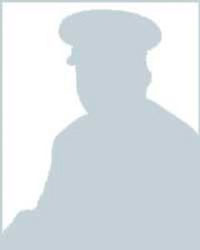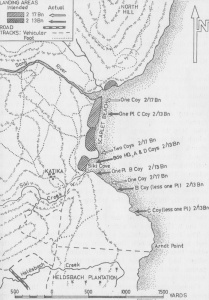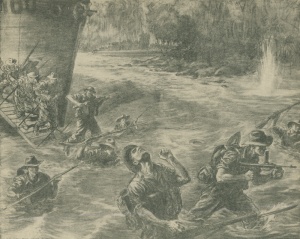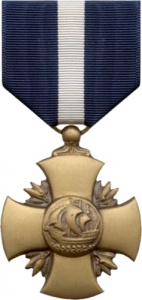Lieutenant Commander John Morrel Band

John Morrel Band (1902–1943) was born on 22 March 1902 in South Shields, England. After a series of ventures in the 1920s and 1930s, he bought property on Bribie Island in Queensland. At the outbreak of the Second World War, he enlisted in the Royal Australian Naval Reserve (Seagoing) and was appointed as a temporary sub lieutenant.
Between 5 October 1939 and 27 July 1940, he served in the armed merchant cruiser HMS Moreton Bay. In November 1939, Moreton Bay took passage to Hong Kong, from where she mounted patrols in north-east Asia, venturing as far north as Vladivostok. The primary objective was to intercept German merchant ships that might sail from Japanese ports in which they had taken refuge. The work was monotonous and often arduous, with long spells at sea in weather that varied from bright and sunny to violently windy and snowing. In June 1940, he was promoted to lieutenant.
Following Italy’s entry into the war, Moreton Bay received orders to proceed to the East Indies Station before steaming, via Cape Town, for service in the North Atlantic. At this juncture, John Band left the ship, taking passage to Colombo in SS Narkunda and, from there, returning to Australia, where he joined HMAS Cerberus (Flinders Naval Depot) in July 1940 for training courses. He remained in Cerberus until February 1941, after which he spent a short period in HMAS Lonsdale (Port Melbourne) before transferring to Sydney, where he served briefly in HMAS Penguin and HMAS Platypus.
In April 1941, he joined the survey vessel HMAS Moresby, remaining in her until August before spending a brief period in Penguin. He then joined the cruiser HMAS Hobart on 3 September 1941, which saw action in the Battle of the Coral Sea in May 1942. In July 1942, he took up a shore appointment in Brisbane as the officer-in-charge of the naval wing at the combined operations training centre at Toorbul Point. He was appointed an acting temporary lieutenant commander on 11 January 1943, and in July received orders to proceed to New Guinea, having been appointed as the officer-in-charge of the mobile base administration unit Fairfax, situated in Port Moresby. He was subsequently appointed the Port Director of Buna, on Papua’s north coast, in August. There, he was praised for his initiative and efforts in transforming the port into a 24-hour operation through the installation of makeshift buoys and lighting.
A conference at the Australian 9th Division headquarters was convened on 18 September 1943 to outline plans for the capture of the Finschhafen–Langemak Bay–Dreger Harbour area. It was thought that a quick amphibious assault would help to gain control of the east coast of the Huon Peninsula and, thereby, the Vitiaz Strait. A New Guinea Force Intelligence summary of 15 September had put the strength of the enemy around Finschhafen at 2,100 but, after the fall of Lae, the estimate was reduced to 350. The disparity could not be reconciled and, consequently, field formations were given both figures.
US Navy Admiral DE Barbey, Commander Amphibious Force South-West Pacific, allotted 4 APDs (high-speed converted destroyers and destroyer escorts used as transports to support US Navy amphibious operations in the Second World War), 15 LCIs (landing craft infantry) and 3 LSTs (landing ship tank) to the operation. A further 8 LCMs (landing craft mechanised) were also made available from a US Army boat battalion. A boat battalion and half a shore battalion from the US 532nd Engineer Boat and Shore Regiment (EBSR) was also made available to aid in supplying the Australian brigade.
It was to the 532nd EBSR that John Band appears to have been attached as the officer-in-charge of the naval beach party. It was responsible for carrying and erecting beach markers that would guide the amphibious assault waves to their designated landing points ashore. The reason behind Band’s attachment to the American unit is unclear, but it is plausible that it was due to his knowledge of amphibious operations learnt during his time at Toorbul, near Bribie Island.
The Finschhafen landing was set for 22 September and would comprise seven assault waves. The 2/13 and 2/17 infantry battalions were to land companies from each on Scarlet Beach to the north, Siki Cove to the immediate south and further south towards Arndt Point on the headland. Scarlett Beach was about 550 metres long and 9 to 12 metres deep, with good firm sand suitable for receiving the larger LSTs. At the northern end of the sandy beach was the mouth of the Song River.
The amphibious force left Lae at 7:30pm on 21 September and steamed toward its objective in calm seas under the cover of darkness. Reveille was sounded a 2:45am on 22 September, and the assaulting troops moved to their amphibious embarkation stations. At 4:45am, 5 escorting US destroyers bombarded the shoreline from 4,500 metres, the flashes of the explosions lighting up the blackness of the beach and giving the barges from the APDs some idea of direction in the darkness. The destroyers were using red tracer rounds and the bombardment was believed to have had a considerable impact on the defending Japanese. When the naval gunfire ceased, wave 1 was dispatched, comprising 16 barges carrying 2 companies from 2/17 and 2/13 battalions. It is unclear in which landing craft John Band was embarked.
As the barges proceeded to the shore in the pre-dawn darkness, some of them veered to the left and, consequently, landed to the south of Scarlett Beach, in Siki Cove. From the beginning of the landing, the Australian and American amphibious scouts (mainly from the 532nd EBSR) had attempted to gather on Scarlett Beach from the various positions in which they had been landed.
John Band, the officer-in-charge of these scouts, was mortally wounded while moving north from Siki Cove to Scarlett Beach. Carrying his equipment to measure depths, he floundered into the water, after being wounded in a desperate attempt to carry out his task. He was subsequently taken to a field hospital, possibly one set up by the 2/8th Field Ambulance or the US 262nd Medical Battalion, where he died the following day. He was buried in the Soputa War Cemetery, near Buna, on 24 September 1943. After the war’s end, he was reburied in the Bomana War Cemetery in Port Moresby.
It is unclear who witnessed and recorded the circumstances surrounding his death, but it is possible that it was either Lieutenant Herman A Koeln or Lieutenant Edward K Hammer, both of whom were US amphibious scouts. During the fighting, they linked up with Lieutenant C Huggett – in charge of 1 Platoon, C Company, 2/13 Battalion – and, despite heavy Japanese opposition, managed to set up range lights, flank markers, make a rapid survey of the beach and radio the result of their reconnaissance to the ships waiting offshore.
On 1 March 1944, details of John Band’s death and heroism became known when the Australian Minister for External Affairs, Herbert V Evatt, received a letter from Nelson Trusler Johnson, the Envoy Extraordinary and Minister Plenipotentiary of the United States of America, based in Canberra, proposing that the late Lieutenant Commander Band be decorated for heroism through the award of a United States Navy Cross. The proposed citation read:
For extraordinary heroism as Officer in Charge of the Naval Beach Party landing at Japanese-occupied Finschhafen, New Guinea on September 22, 1943. Repeatedly exposing himself to fierce enemy machinegun and mortar fire, Lieutenant Commander Band valiantly led the first wave of landing forces ashore despite persistent hostile bombing and strafing attacks on our ships and beach objectives. Although fatally wounded during this action, he tenaciously continued to direct the hazardous operations and prevented one group of landing craft from beaching in the wrong area where opposition was extremely heavy. Still carrying on, he finally collapsed and was returned to a field hospital. By his daring leadership and selfless devotion to duty, Lieutenant Commander Band contributed in large measure to the successful completion of a vital mission. He gallantly gave his life in the serve of his country.
The offer of an award of a US Navy Cross to John Band was gratefully accepted by the Australian Government on 17 May 1944, and a presentation was made to his next of kin on 28 March 1945 by the Commander of US Naval Forces in Europe, Admiral Harold Stark.
Lieutenant Commander Band was one of only three officers of Australia’s naval forces to be decorated with this prestigious award.





